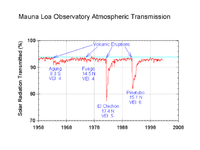
Photo from wikipedia
Abstract Authigenic carbonates and pyrite associated with sulfate-driven anaerobic oxidation of methane (AOM) at methane seeps provide archives to explore the biogeochemical processes involved and seepage dynamics over time. The… Click to show full abstract
Abstract Authigenic carbonates and pyrite associated with sulfate-driven anaerobic oxidation of methane (AOM) at methane seeps provide archives to explore the biogeochemical processes involved and seepage dynamics over time. The wide range and extremely high δ34S values of pyrite (δ34Spy) have been used to trace the AOM-related processes. However, the detailed mechanism for this phenomenon is not well understood. We propose that the characteristics of δ34Spy were mainly controlled by the competition between sulfate reduction and sulfate supply, as well as the redox condition. To test this hypothesis, we investigated Sr/Ca and Mg/Ca ratios, trace element compositions, pyrite contents and sulfur isotopic compositions in seep carbonates from Site F and Haima in the northern South China Sea. Calcite and aragonite contents were distinguished through the Sr/Ca and Mg/Ca ratios. The data show that aragonites are always associated with relatively low δ34Spy values compared to calcites. The Mo contents show a good correlation with pyrite contents in calcites and aragonites, and the slope in aragonites is larger than that in calcites. This relationship indicates that the aragonite precipitated in a relatively open system with higher Mo availability. Thus, we conclude that sulfides with low δ34S values formed at high supply of sulfate under the relatively open system with respect to diffusive replenishment of sulfate, where the carbonate precipitation occurred close to the seafloor due to a strong methane flux. Under vigorous methane flux simultaneously, the high potential of less anoxic conditions, which could limit the additional pyrite accumulation and/or favor the microbial disproportionation, could also be the cause of the low δ34Spy, as supported by samples from the Haima sites. Evidence for this assumption is based on the occurrence of bivalve shells and less enrichment in As and Sb. Conversely, the positive δ34Spy values result from near to complete exhaustion of dissolve sulfate via AOM within a deeper sulfate-methane transition zone, where Mo is less available. The combination of a detailed elemental study of authigenic carbonates with sulfur isotopic composition of sulfide minerals in carbonates is a promising tool for reconstructing the dynamics of seep intensities at modern and, potentially, geological seep sites.
Journal Title: Journal of Asian Earth Sciences
Year Published: 2018
Link to full text (if available)
Share on Social Media: Sign Up to like & get
recommendations!